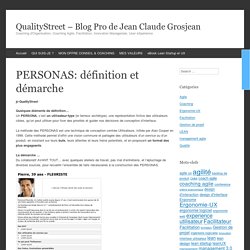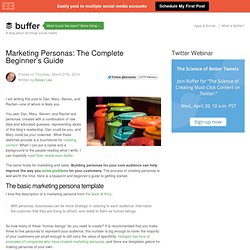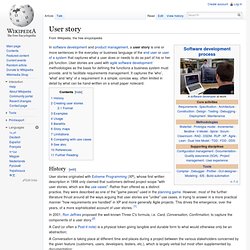

Design Thinking With Persona. La méthode des PERSONAS. Quelques éléments de définition… Un PERSONA, c’est un utilisateur-type (le fameux archétype), une représentation fictive des utilisateurs cibles, qu’on peut utiliser pour fixer des priorités et guider nos décisions de conception d’interface.

La méthode des PERSONAS est une technique de conception centrée Utilisateurs, initiée par Alan Cooper en 1999. Cette méthode permet d’offrir une vision commune et partagée des utilisateurs d’un service ou d’un produit, en insistant sur leurs buts, leurs attentes et leurs freins potentiels, et en proposant un format des plus engageants. La démarche … Du collaboratif AVANT TOUT… avec quelques ateliers de travail, pas mal d’entretiens, et l’épluchage de diverses sources, pour recueillir l’ensemble de faits nécessaires à la construction des PERSONAS.
Une démarche en 3 temps:PREPARER – CONSTRUIRE – COMMUNIQUER ET UTILISER… 1 Préparer Le démarrage dont tout va dépendre. 2 Construire La phase la plus délicate. 3 Communiquer et Utiliser Quelques liens: The Complete Beginner's Guide to Creating Marketing Personas. 4.7K Flares Filament.io 4.7K Flares × I am writing this post to Dan, Mary, Steven, and Rachel—one of whom is likely you.

You see, Dan, Mary, Steven, and Rachel are personas, created with a combination of raw data and educated guesses, representing slices of this blog’s readership. Dan could be you, and Mary could be your coworker. What these sketches provide is a touchstone for creating content: When I can put a name and a background to the people reading what I write, I can hopefully meet their needs even better. The same holds for marketing and sales. The basic marketing persona template I love this description of a marketing persona from the team at Krux: With personas, businesses can be more strategic in catering to each audience, internalize the customer that they are trying to attract, and relate to them as human beings.
So how many of these “human beings” do you need to create? Many of these templates include the same basic information. Name of the persona Job title Demographics. How-to-Create-a-Buyer-Persona-and-Journey.pdf. Why Buyer Persona Development Should Be a Team Effort. High quality buyer personas enable marketing teams to create content that is compatible with the wants and needs of a business' ideal customer.

They serve as a foundation for great content strategies, informing everything from blog titles to proper distribution. We know this. However, marketers aren't the only ones who should have a say in the development. While buyer personas certainly enable marketers to create targeted content, it's that targeted content that attracts high quality leads for sales to close and client services to work with. It's a linear path to growth and success that starts with knowing (in great detail) who your ideal customers are.
If your personas don't reflect a collaborative effort between all departments, it's going to influence everyone's ability to do their job correctly. Are you picking up what I'm putting down here? If so, we've outlined how to go about collecting the company-wide insights you need to transform your buyer personas from vague to invaluable. User story. History[edit] User stories originated with Extreme Programming (XP), whose first written description in 1998 only claimed that customers defined project scope "with user stories, which are like use cases".

Rather than offered as a distinct practice, they were described as one of the "game pieces" used in the planning game. However, most of the further literature thrust around all the ways arguing that user stories are "unlike" use cases, in trying to answer in a more practical manner "how requirements are handled" in XP and more generally Agile projects. This drives the emergence, over the years, of a more sophisticated account of user stories. [1] In 2001, Ron Jeffries proposed the well-known Three C's formula, i.e. A Card (or often a Post-it note) is a physical token giving tangible and durable form to what would otherwise only be an abstraction; The Confirmation, the more formal the better, ensures that the objectives the conversation revolved around have been reached finally.
Run tests.